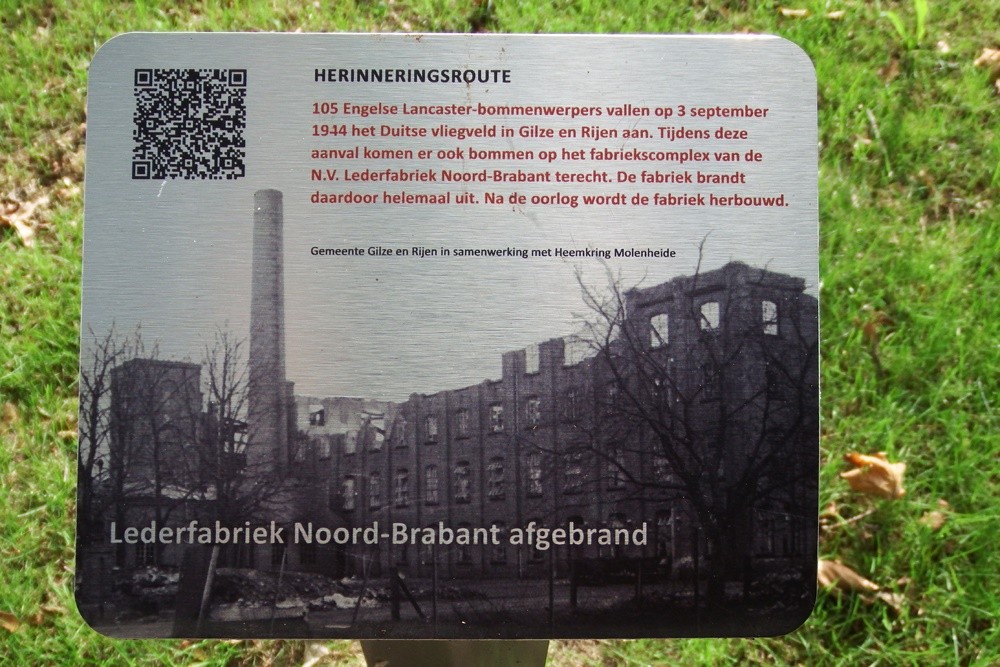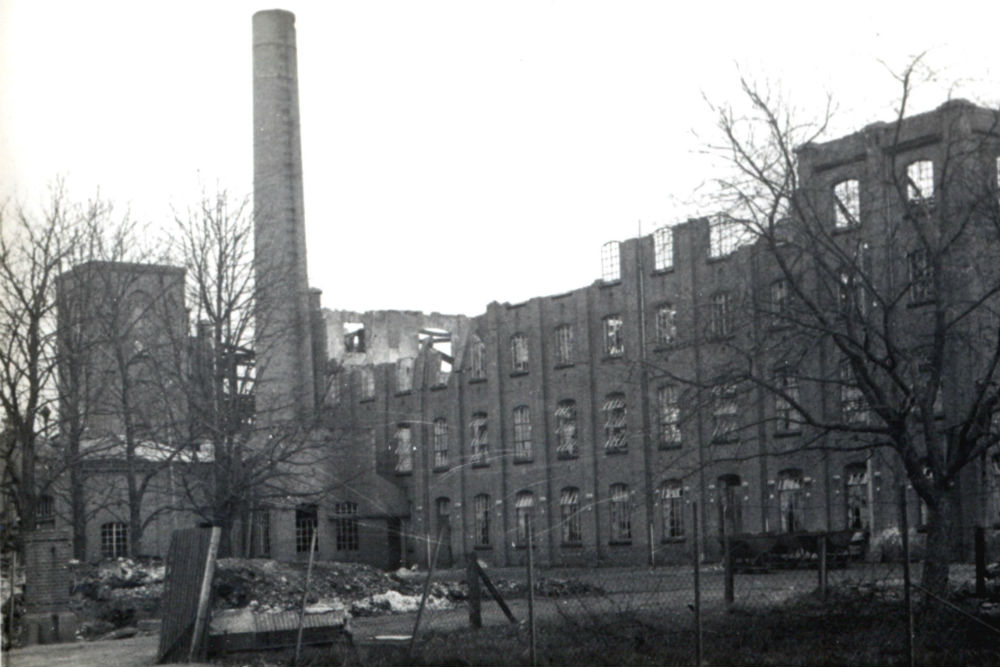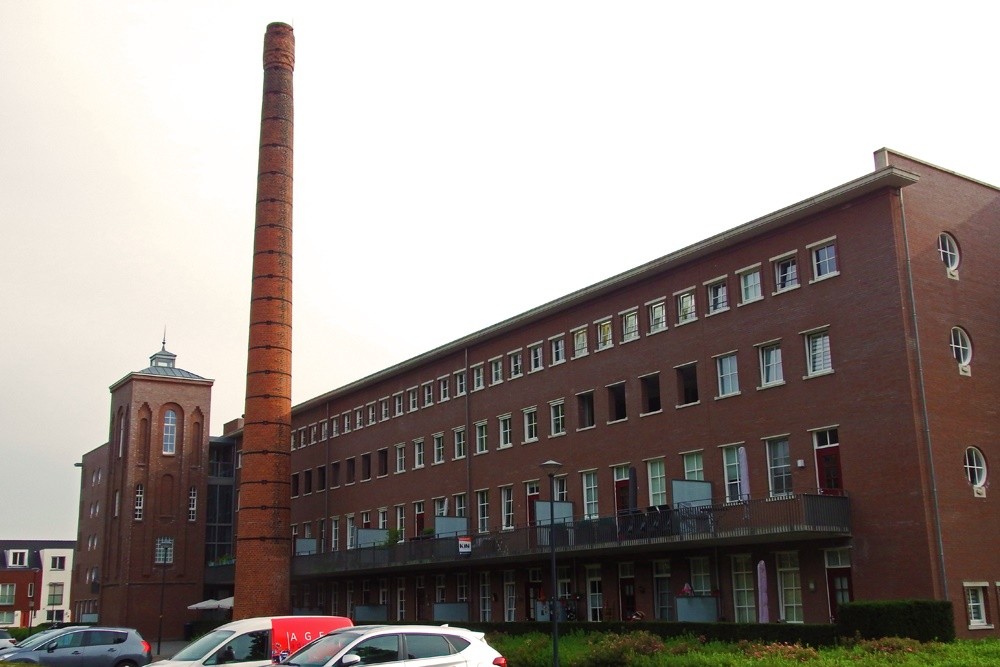Memory Route World War ll Lederfabriek North Brabant Burned in Rijen
In the Municipality of Gilze and Rijen is a memory route created in memory of the Second World War.
In a number of places there is a sign with a description of what happened at that place in the Second World War.
LEATHER FACTORY NORTH BRABANT BURNED DOWN
The establishment of N.V. Lederfabriek Noord-Brabant
The N.V. Lederfabriek Noord-Brabant was founded on 18 March 1911. The founders of this factory are Messrs Uijtendaal sr. And Van Bijsterveldt. Construction will start on a factory on Julianastraat. In October 1911, the factory was completed and it opened its gateway. The well-known architect P. Aarts from Rijen is responsible for the design of the four floors, engine room / boiler house and porter's house. A villa with coach house, a director's house, a water tower, a high-voltage area and various stables will soon follow at the complex's location. The entire factory complex is approximately 5400 m2.
The factory has two steam engines, each delivering 250 hp, to power the machinery.
The workforce is growing over the years. In 1936, during its 25th anniversary, 130 people work there.
The factory focuses on large-scale production of so-called sole leather for the shoe industry. The sole and insole of shoes are made of sole leather, thick and sturdy cow leather.
The bombing of September 3, 1944
In preparation for the planned Operation Market-Garden (17-25 September 1944), the Allies attack all German airports in the south of the Netherlands. The aim is to eliminate German air defense. On September 3 at 15.25 the first air alarm goes off in Gilze and Rijen. A final alarm sounds at 15.50. There doesn't seem to be much going on yet. At 4:40 p.m., however, fighters reappear in the air, followed by 105 British Lancaster bombers dropping their cargo at Gilze and Rijen airfield. The majority of the bombs end up at the airport, but a number of series of bombs also drop in the core of Hulten. The church and adjacent school are destroyed and the surrounding buildings are severely damaged. Bombs also end up in the wider area, including Haansberg, Rijen and Molenschot.
The factory complex of N.V. Lederfabriek Noord-Brabant on the Julianastraat is also affected. Fire breaks out. The voluntary fire brigade of the municipality is called up and will be on site within 2 minutes with 2 motor sprayers. However, the 19-man squad cannot do much. As a result of the bombing, the water pipe is damaged in such a way that there is no more pressure on the pipes. Later in the evening there will also be a reinforcement of 10 men from the Tilburg fire brigade. Because they too cannot do anything, they are almost immediately sent back to Tilburg.
The powerless fire brigade can only see that the factory complex largely burns down. Post-filling lasts until 4 p.m. the following day.
From reconstruction to the present
Soon after the liberation, plans are made to rebuild the factory complex on the same site. The foundations of the original factory and the trusses still prove to be usable, which comes in handy in the time of scarce building material. However, only the chimney and the water tower of the original building remain. An engine room / power plant / high-voltage area will also be built at the new building.
The leather market collapses and the factory goes bankrupt around 1956. Mr. J. Verbunt from Dongen, also a tanner, buys the factory and continues to tanner on the spot. In June 1959 he was unable to keep his head above water and the factory closed its gates permanently.
A year later, the complex becomes a wallpaper factory, led by the new owner, Mr. I. Cohen from Rotterdam. This new destination also requires the necessary adjustments to the complex. Mr. Cohen has a new office built and next to the chimney he builds a new boiler house. The old boiler house is being transformed into a canteen. A production hall is being converted into a dyeing / printing shop, a warehouse is being added and a loading and unloading area is being added. The factory is then called: "Dutch Wallpaper Industry N.V.".
Later some adjustments to the factory will follow. A second boiler will be installed in the boiler house, and additional storage spaces will be created.
In 1971 the factory name changed to Goudsmit-Hoff. The factory becomes the sponsor of one of the most successful cycling teams in the history of the Netherlands.
In 1980, the competitor Rath and Doodeheefver takes over the factory. Until 1998, this big name in the wallpaper world produces here, among other things, its wallpaper. In 1998 Rath and Doodeheefver went bankrupt and until 2008 the factory was empty.
The factory and the site were bought in that year by a private construction company to build a new residential area. The plan is to keep the original building.
However, in 2009 the building turned out to be in too bad a condition to be preserved.
The factory is demolished and an apartment complex is built on the site of the factory, resembling the old factory in appearance.
Do you have more information about this location? Inform us!
Source
- Text: TracesOfWar
- Photos: Peter van Hoek (1, 3), Heemkring Molenheide (2)
- www.heemkringmolenheide.nl
Nearby
Point of interest
- Memory Route World War ll Trooper Barracks Destroyed Rijen - Rijen (Gilze en Rijen)
- Memory Route World War ll Ammunition Train Station Rijen - Rijen (Gilze en Rijen)
- Former German Settlement Siedlung Rijen - Rijen (Gilze en Rijen)
Monument
- Liberation Route Marker 143: Gilze-Rijen airfield - Rijen (Gilze-Rijen)
- Memorial Killed N.S. Employee Rijen - Rijen (Gilze en Rijen)
- Memorial Dambuster Crew S for Sugar - Gilze-Rijen
Cemetery
- Graves Civilian Victims Catholic Cemetery Hulten - Hulten (Gilze en Rijen)
- Commonwealth War Graves Roman Catholic Cemetery Gilze - Gilze (Gilze en Rijen)
- Collective Grave Civilian Casualties Roman Catholic Cemetery Gilze - Gilze (Gilze en Rijen)
Remembrance Stone
- Stumbling Stone Hoogstraat 80 - Oosterhout
- Stumbling Stone Klappeijstraat 46 - Oosterhout
- Stumbling Stone Leijsenhoek 73 - Oosterhout
Fortification
- Remnant Bunker Airport Gilze Rijen - Molenschot (Gilze en Rijen)
- Remnant Bunker Airport Gilze Rijen - Molenschot (Gilze en Rijen)
- Remnant Bunker Airport Gilze Rijen - Molenschot (Gilze en Rijen)







